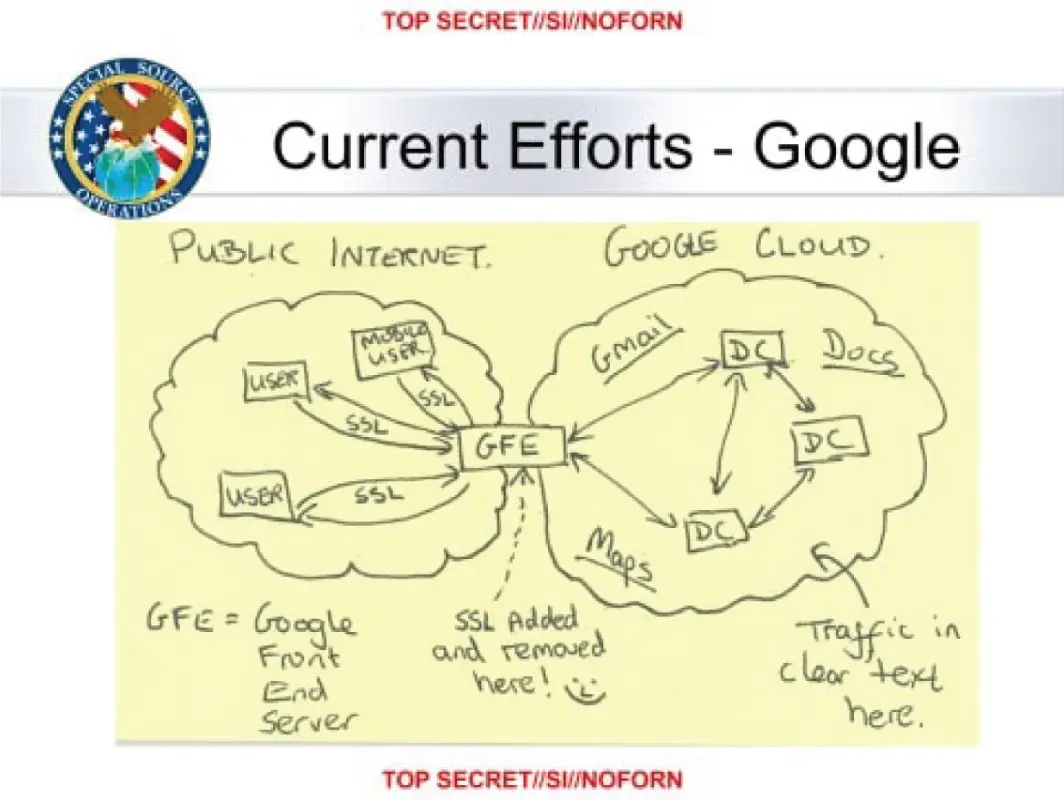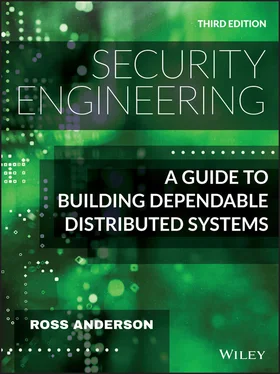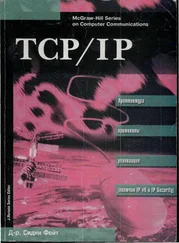Two years later, at a meeting at Princeton which Snowden attended in the form of a telepresence robot, he pointed out that a lot of Internet communications that appear to be encrypted aren't really, as modern websites use content delivery networks (CDNs) such as Akamai and Cloudflare; while the web traffic is encrypted from the user's laptop or phone to the CDN's point of presence at their ISP, it isn't encrypted on the backhaul unless they pay extra – which most of them don't [87]. So the customer thinks the link is encrypted, and it's protected from casual snooping—but not from nation states or from firms who can read backbone traffic.

Figure 2.1 : Muscular – the slide
2.2.1.4 Special collection
The NSA and CIA jointly operate the Special Collection Service (SCS) whose most visible activity may be the plastic panels near the roofs of US and allied embassies worldwide; these hide antennas for hoovering up cellular communication (a program known as ‘Stateroom’). Beyond this, SCS implants collection equipment in foreign telcos, Internet exchanges and government facilities. This can involve classical spy tradecraft, from placing bugs that monitor speech or electronic communications, through recruiting moles in target organisations, to the covert deployment of antennas in target countries to tap internal microwave links. Such techniques are not restricted to state targets: Mexican drug cartel leader ‘El Chapo’ Guzman was caught after US agents suborned his system administrator.
Close-access operations include Tempest monitoring: the collection of information leaked by the electromagnetic emissions from computer monitors and other equipment, described in 19.3.2. The Snowden leaks disclose the collection of computer screen data and other electromagnetic emanations from a number of countries' embassies and UN missions including those of India, Japan, Slovakia and the EU 2.
2.2.1.5 Bullrun and Edgehill
Special collection increasingly involves supply-chain tampering. SCS routinely intercepts equipment such as routers being exported from the USA, adds surveillance implants, repackages them with factory seals and sends them onward to customers. And an extreme form of supply-chain tampering was when the NSA covertly bought Crypto AG, a Swiss firm that was the main supplier of cryptographic equipment to non-aligned countries during the Cold War; I tell the story in more detail later in section 26.2.7.1.
Bullrun is the NSA codename, and Edgehill the GCHQ one, for ‘crypto enabling’, a $100m-a-year program of tampering with supplies and suppliers at all levels of the stack. This starts off with attempts to direct, or misdirect, academic research 3; it continued with placing trusted people on standards committees, and using NIST's influence to get weak standards adopted. One spectacular incident was the Dual_EC_DRBGdebacle, where NIST standardised a random number generator based on elliptic curves that turned out to contain an NSA backdoor. Most of the actual damage, though, was done by restrictions on cryptographic key length, dovetailed with diplomatic pressure on allies to enforce export controls, so that firms needing export licenses could have their arms twisted to use an ‘appropriate’ standard, and was entangled with the Crypto Wars (which I discuss in section 26.2.7). The result was that many of the systems in use today were compelled to use weak cryptography, leading to vulnerabilities in everything from hotel and car door locks to VPNs. In addition to that, supply-chain attacks introduce covert vulnerabilities into widely-used software; many nation states play this game, along with some private actors [892]. We'll see vulnerabilities that result from surveillance and cryptography policies in one chapter after another, and return in Part 3of the book to discuss the policy history in more detail.
With such a vast collection of data, you need good tools to search it. The Five Eyes search computer data using Xkeyscore, a distributed database that enables an analyst to search collected data remotely and assemble the results. Exposed on July 31 2013, NSA documents describe it as its “widest-reaching” system for developing intelligence; it enables an analyst to search emails, SMSes, chats, address book entries and browsing histories [816]. Examples in a 2008 training deck include “my target speaks German but is in Pakistan. How can I find him?” “Show me all the encrypted Word documents from Iran” and “Show me all PGP usage in Iran”. By searching for anomalous behaviour, the analyst can find suspects and identify strong selectors (such as email addresses, phone numbers or IP addresses) for more conventional collection.
Xkeyscore is a federated system, where one query scans all sites. Its components buffer information at collection points – in 2008, 700 servers at 150 sites. Some appear to be hacked systems overseas from which the NSA malware can exfiltrate data matching a submitted query. The only judicial approval required is a prompt for the analyst to enter a reason why they believe that one of the parties to the conversation is not resident in the USA. The volumes are such that traffic data are kept for 30 days but content for only 3–5 days. Tasked items are extracted and sent on to whoever requested them, and there's a notification system (Trafficthief) for tipping off analysts when their targets do anything of interest. Extraction is based either on fingerprints or plugins – the latter allow analysts to respond quickly with detectors for new challenges like steganography and homebrew encryption.
Xkeyscore can also be used for target discovery: one of the training queries is “Show me all the exploitable machines in country X” (machine fingerprints are compiled by a crawler called Mugshot). For example, it came out in 2015 that GCHQ and the NSA hacked the world's leading provider of SIM cards, the Franco-Dutch company Gemalto, to compromise the keys needed to intercept (and if need be spoof) the traffic from hundreds of millions of mobile phones [1661]. The hack used Xkeyscore to identify the firm's sysadmins, who were then phished; agents were also able to compromise billing servers to suppress SMS billing and authentication servers to steal keys; another technique was to harvest keys in transit from Gemalto to mobile service providers. According to an interview with Snowden in 2014, Xkeyscore also lets an analyst build a fingerprint of any target's online activity so that they can be followed automatically round the world. The successes of this system are claimed to include the capture of over 300 terrorists; in one case, Al-Qaida's Sheikh Atiyatallah blew his cover by googling himself, his various aliases, an associate and the name of his book [1661].
There's a collection of decks on Xkeyscore with a survey by Morgan Marquis-Boire, Glenn Greenwald and Micah Lee [1232]; a careful reading of the decks can be a good starting point for exploring the Snowden hoard 4.
Bulk key theft and supply-chain tampering are not the only ways to defeat cryptography. The Xkeyscore training deck gives an example: “Show me all the VPN startups in country X, and give me the data so I can decrypt and discover the users”. VPNs appear to be easily defeated; a decryption service called Longhaul ingests ciphertext and returns plaintext. The detailed description of cryptanalytic techniques is held as Extremely Compartmented Information (ECI) and is not found in the Snowden papers, but some of them talk of recent breakthroughs in cryptanalysis. What might these be?
Читать дальше












